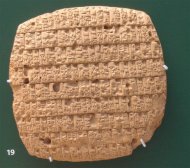Drought May Have Killed Sumerian Language
By Tia Ghose, LiveScience Staff Writer | LiveScience.com – 8 hrs ago
SAN FRANCISCO — A 200-year-long drought 4,200 years ago may have killed off the ancient Sumerian language, one geologist says.
Because no written accounts explicitly mention drought as the reason
for the Sumerian demise, the conclusions rely on indirect clues. But
several pieces of archaeological and geological evidence tie the gradual
decline of the Sumerian civilization to a drought.
The findings, which were presented Monday (Dec. 3) here at the annual meeting of the American Geophysical Union, show how vulnerable human society may be to climate change, including human-caused change.
"This was not a single summer or winter, this was 200 to 300 years of drought," said Matt Konfirst, a geologist at the Byrd Polar Research Center.
Beginning about 3500 B.C., the Sumerian culture flourished in ancient Mesopotamia,
which was located in present-day Iraq. Ancient Sumerians invented
cuneiform writing, built the world's first wheel and arch, and wrote the
first epic poem, "Gilgamesh." [Image Gallery: Ancient Middle-Eastern Texts]
But after 200 to 300 years of upheaval, the Sumerian culture disappeared around 4,000 years ago, and the Sumerian language went extinct soon after that.
Konfirst wanted to see if a drought
that spanned about 200 years may have caused the decline. Several
geological records point to a long period of drier weather in the Middle
East around 4,200 years ago, Konfirst said. The Red Sea and the Dead
Sea had increased evaporation; water levels dropped at Lake Van in
Turkey, and cores from marine sediments around that period indicate
increased dust in the environment.
"As we go into the 4,200-year-ago climate anomaly, we actually see that
estimated rainfall decreases substantially in this region and the
number of sites that are populated at this time period reduce
substantially," he said.
Around the same time, 74 percent of the ancient Mesopotamian settlements
were abandoned, according to a 2006 study of an archaeological site
called Tell Leilan in Syria. The populated area also shrank by 93
percent, he said.
"People still live in this region. It's not that the collapse of a
civilization means that an area is completely abandoned," he said. "But
that there's a sharp change in the population."
During the great drought, two waves of marauding nomads descended upon
the region, sacking the capital city of Ur. After around 2000 B.C.,
ancient Sumerian gradually died off as a spoken language in the region.
For the next 2,000 years, the tongue lingered on as a dead written language, similar to Latin in the Middle Ages, but has been completely extinct since then, Konfirst said.
The coincidence of the social upheaval, depopulation in the area and
the geologic record of drought suggests climate change might have played
a role in the loss of the Sumerian language, Konfirst said.
The findings a

No comments:
Post a Comment